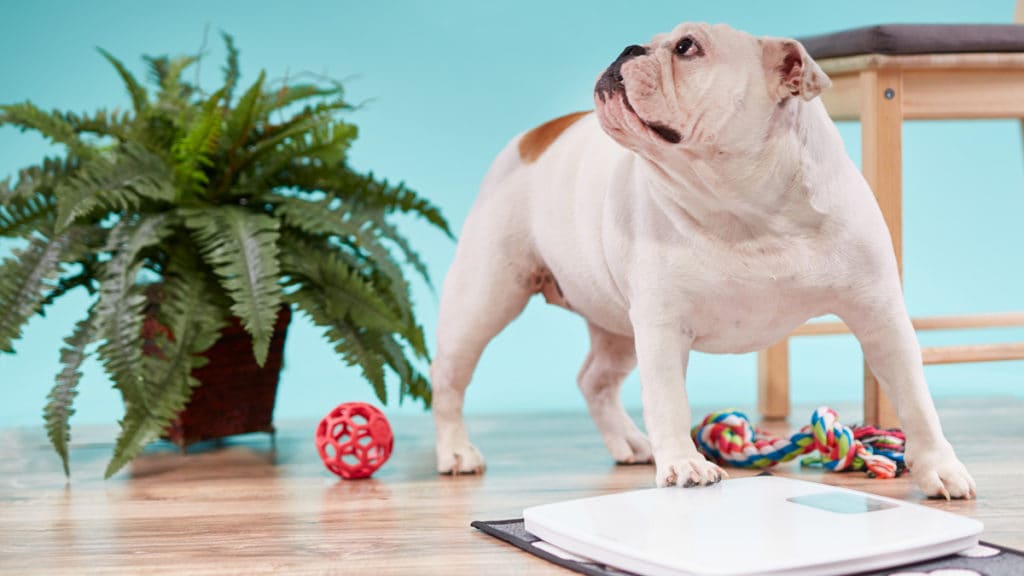While we’re sure there is a lot to love about your pet, the truth is that too often pet parents miss the fact that their furry best friends are suffering from weight issues. In fact, studies have found that over 50 percent of both cats and dogs in the US are overweight, says Dr. Ann Hohenhaus, staff doctor at New York City’s Animal Medical Center.
Signs Your Dog Might Be Overweight
While there are certain signs that dog owners can be on the lookout for that might mean their pup is a fat dog, Dr. Hohenhaus cautions taking any one sign in particular to mean that he definitely is. “Vets talk about a body condition score,” she said. “Some vets will score dogs on a scale of 1 to 9, or 1 to 5, but with either scale, we’re talking about using certain criteria to assess whether a pet is overweight or obese. To score a patient on this scale, we look at a whole number of factors to provide an overall assessment.”
The reason is because dogs are the only species where its members have a 100-fold difference in terms of body weight, Dr. Hohenhaus added. For example, a dog that weighs 20 pounds could be an overweight Chihuahua that’s meant to weigh 10 pounds, or an underweight Spaniel that should weigh 30 pounds.
So, what are the signs that you have a fat dog? Here are the ones Dr. Hohenhaus listed:
1. Trouble jumping on furniture.
If your pet has always been eager to hop on the couch (or chair or bed) right next to you, and these days it’s taking him a while (or it’s impossible) to do so, he could be overweight. Extra fat is a direct result of your dog nutrition and puts unwanted pressure on joints, making it harder for overweight pets to do their normal jumping.
2. Difficulty breathing, especially during short bouts of exercise.
Obesity can also impair respiratory function in dogs, so if you catch your pet wheezing or struggling to breathe at any point, it’s best to take her into the vet for an assessment.
3. A waddling gate.
If you have a fat dog, she may not be able to get her legs under her properly to walk. “If that’s the case, or if her legs stick out to the side, you may notice a rolling gate in your pet,” said Dr. Hohenhaus.
4. Snoring.
The previously mentioned impaired respiratory function might manifest itself in another unusual symptom — snoring. “I had a patient that had gained a lot of weight and his owner brought him in because he was snoring,” said Dr. Hohenhaus. “We did a CT scan and discovered that the animal had gained so much weight, it was causing respiratory noises because the back of his throat was fatter, causing breathing issues. Snoring could also mean nasal infection, but it could be a sign of weight gain when taken in context with other symptoms.”
5. Appearance.
You might think an overweight dog would be easy to spot by appearance alone, but according to Dr. Hohenhaus, many pet parents simply miss the signs. “If your pet is a good weight, you shouldn’t see ribs sticking out, but you should be able to feel them easily under the skin,” she said. Additionally, if you look at your pet from the side, she should be wider in the chest and narrower in the waistline. Likewise, if you stand over your dog and look down, she should be wider throughout the chest and narrower through her abdomen. “If your dog is more sausage-shaped from an areal view, she’s too fat,” cautions Dr. Hohenhaus. Some fat dogs also get roles of fat that appear as wrinkles or puckers at the base of their tail.
6. General Lethargy.
As you can imagine, if your dog is exhibiting any of the aforementioned symptoms of obesity, he’ll probably be less likely to be interested in any of his old favorite activities. A dog with no overall energy could be suffering from excess weight.
If your dog is exhibiting any of the above signs and you believe she could be overweight, take her to the vet for an assessment. You might not think it matters if your dog is carrying a few extra pounds, but according to studies, dogs that were fed less and stayed thinner than those who were overweight had better dog nutrition and lived longer, says Dr. Hohenhaus. “People want to keep their pets healthy and living for as long as they can, so keeping a pet thin should be on the top of the list of things that are a pet owner’s priority,” says Dr. Hohenhaus.
How to Get Your Overweight Dog to Drop the Extra Pounds
One way to stay on top of your dog’s weight is to pay special attention to his diet. “There’s nothing more fun than having your pet dance around for treats or table food, but in a study of pets that were overweight, feeding table food and excess snacks was associated with their weight gain,” said Dr. Hohenhaus. Instead of treating your pudgy pet to people food, consider rewarding him with weight conscious dog treats like Greenies Weight Management Teenie Dental Dog Treats or Hill’s Prescription Diet Dog Treats.
Besides avoiding table food, Dr. Hohenhaus also cautions dog owners that not all treats or cans or bags of dog food are created equal, calorie-wise. “Canned dog food can range from 250 to 450 calories, which is a huge difference,” she said. “So you can’t just feed your dog a can — you have to figure out how many calories your pet needs per day, and then feed her the number of cans (or scoops of dry food) equal to that amount. Consult with your vet for advice.” And, consider asking your vet about switching to a weight management food like Hill’s Prescription Diet w/d Digestive/Weight/Glucose Management to better control his calories intake and dog nutrition.
If you’re in the market for some healthier dog food and treat options and remember to also always consult with your vet before changing your dog’s diet.
Share:












